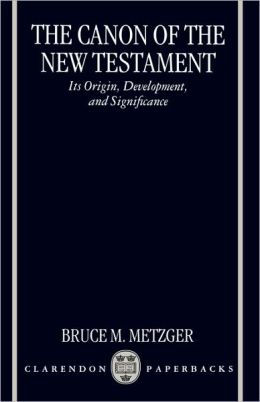 Bruce Metzger’s, The Canon of the New Testament, is an examination of the development of the New Testament canon from the first century to the twentieth century. Yet, this book is more than a historical treatise on the canon; it also speaks to theological interests invested in canonicity (v). The book is structured in three parts: Part One is a survey of scholarly literature on canon formation; Part Two is an investigation through primary sources of canon formation; and Part Three is an exploration of the historical and theological issues surrounding the concept of canonicity.
Bruce Metzger’s, The Canon of the New Testament, is an examination of the development of the New Testament canon from the first century to the twentieth century. Yet, this book is more than a historical treatise on the canon; it also speaks to theological interests invested in canonicity (v). The book is structured in three parts: Part One is a survey of scholarly literature on canon formation; Part Two is an investigation through primary sources of canon formation; and Part Three is an exploration of the historical and theological issues surrounding the concept of canonicity.
In Part One, Metzger offers a detailed survey of the scholarly literature on canon formation from the seventeenth century through the twentieth century. He provides a sufficient review of the major scholars and their works and does a thorough job in highlighting the pressing topics regarding canonicity as they varied throughout the centuries.
Part Two of this book is a cache of valuable information. Although Metzger’s historical survey covers an expansive time frame, beginning at the end of the first century and ending at the twentieth century, he focuses his attention and fastidious research on the first four centuries.
Beginning with the Apostolic Fathers, Metzger considers this collection to represent a period of canonical preparation, where authority is not placed on a certain collection of books but rather is ascribed to the Law and the Prophets, sayings of Jesus, and apostolic sayings. Despite a few references to “the Gospel,” the majority of Jesus and apostolic saying are allusions, lacking clear and authoritative references to any particular text. Many of the allusions, nevertheless, can be traced back to canonical Gospels and Epistles, which leads Metzger to conclude that the authors of the Apostolic Fathers regard the books that would later become canonical with an “implicit authority” (73).
Before tracing the development of the canon beyond the period of the Apostolic Fathers, Metzger examines the possible reasons that precipitated the need for an authoritative collection of Christian writings. He views the conflict between the “Great Church”––as he calls it––and other Christian groups as the principal impetus for the future establishment of the canon. For example, Marcion’s rejection of Jewish scripture and Jewish contexts in the Gospels and Pauline letters caused the Church to “recognize the breadth of the written corpus as authoritative” (106). He further suggests that canon formation was influenced by persecution, during which Christians would likely be forced to choose with little delay which books they are willing to hand over to authorities and for which ones they are willing to suffer. He also mentions book making as well as Jewish and pagan constructions of lists of (authoritative) books as other possible influences perpetuating the development of the Christian canon.
After expounding on these polemical relationships and circumstances, Metzger then surveys canon formation through the Eastern and Western churches and discusses at length two early Christian book lists: the Muratorian Canon and Eusebius’ list. The results of his investigation show that it is only near the end of the second century that we first find, in Clement of Alexandria and Ireneaus, a four-fold gospel standard. According to Metzger, one exception to this later date is Tatian’s early second-century Diaterssaron, which shows that Tatian viewed Matthew, Mark, Luke, and John as the only authoritative Gospels; a conclusion he maintains despite his acknowledgment of extra-canonical material in the harmony (115–16). Apostolic writings, on the other hand, are still fluid as late as the early fourth century, as there is yet no consensus of which writings are to be considered authoritative and which ones are to be eschewed.
Metzger devotes two chapters to Christian attempts at finalizing a determinative canon. By adducing an extensive array of evidence from the fourth century to the present, he shows that in the East the concept of canonicity is still, as of the twentieth century, a fluid idea, while in the West the canon eventually found more stability in the sixteenth century––at least as it concerns the books of the New Testament.
In accord with his stated intent given in the preface, Part Three incorporates the theological results of the historical endeavor thus far. He begins by laying out three criteria used by the church fathers to determine which books would be considered canonical: those that attested to a “rule of faith” (defined by Metzger as those which adhered to the Christian tradition “recognized as normative by the Church” [251]), those perceived to be of legitimate apostolic authorship, and those that were generally accepted as authentic (251–254). Notably, a criterion of inspiration is omitted from this list; Metzger concludes that inspiration was not used to ascribe canonical status because the early church leaders frequently viewed anyone––even their contemporaries––who wrote or spoke under the guidance of the Spirit to be inspired. He ends the book with a discussion on current issues regarding canonicity, including: whether today the canon can considered open or closed, whether it is appropriate to speak of a canon within a canon, and whether the canon is a collection of authoritative books or an authoritative collection of books.
Metzger does include a discussion on canonicity and apocryphal literature, but it is one of the more curious parts of his book. In this chapter he gives adequate attention to apocryphal Gospels, Acts, Epistles, Apocalypses, and a few “Miscellaneous Writings”––which is largely made up of writings from the Apostolic Fathers. The attention given to these works is that of illustrating why the “Great Church” eventually rejected them. The reason: they contain aberrant theological views, possess little, if any, historical veracity, and are unable to convincingly demonstrate apostolicity.
For all the astute historical examination and detail that permeates this fine book, this chapter on apocryphal literature is indeed odd. It appears that instead of merely illustrating why the “Great Church” rejected certain Christian writings, Metzger uses this chapter to defend the position of the Church by traducing those writings that stand beyond the limits of a later orthodox standard. Thus, he argues that the apocryphal works are “romantic,” “fanciful,” “strange,” and “entertaining” (168–69, 174, 175, 177, 178) writings for a “popular” audience (168, 175, 178) that belie their own historicity and apostolicity (168–69, 173, 174, 175, 177, 179). This rhetoric is problematic for a number of reasons, not least that these pejorative claims are one-sided and never fall against those writings more widely accepted by the “Great Church,” like the Shepherd of Hermas, or even those writings which eventually received canonical status, like the Acts of the Apostles or Revelation. This selective use of derogatory rhetoric enables Metzger to appeal to textual agency and conclude that “certain books exclude themselves from the canon” (286) while the canonical books “established themselves” (173). Metzger’s appeal to an absolute claim against apostolic and historical authenticity of apocryphal literature is also problematic, as it does not allow him to convincingly defend the pseudepigraphical nature of some canonical material when he argues that canonicity “is not affected by features that are open to adjudication, such as matters of authorship and genuineness” (284). Unfortunately for his argument, false authorial claims and suspect genuineness are precisely the grounds by which he adjudicates that apocryphal literature is to be rejected.
Despite this peculiar examination of apocryphal literature, Metzger’s book is nevertheless a thorough and erudite investigation into the development of the New Testament canon. This is indeed a volume that should appear on the self of every student of early Christianity, who will no doubt return to it again and again to retrieve its valuable information.


